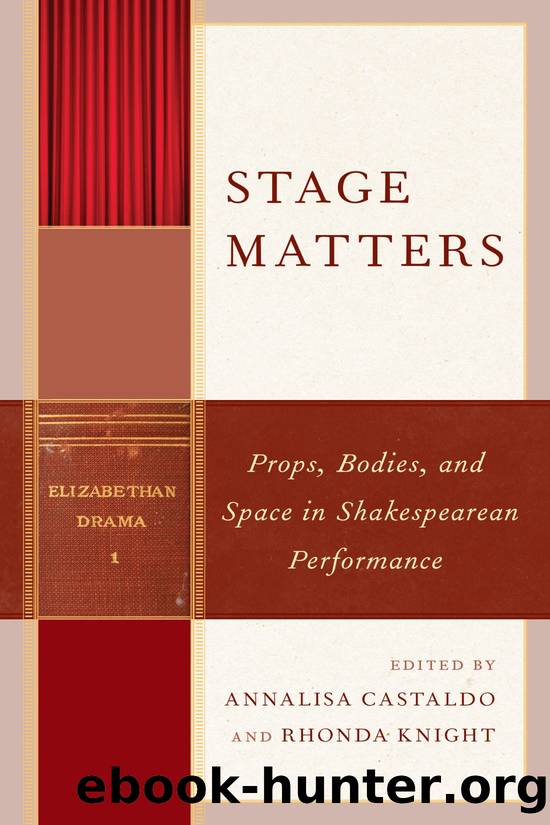Stage Matters by unknow

Author:unknow
Language: eng
Format: epub
Publisher: Fairleigh Dickinson University Press
Chapter Six
â¼
Hiding in Plain Sight
Eavesdropping and the Physicality of the Stage
Annalisa Castaldo and Rhonda Knight
The convention of eavesdropping or overhearing is a well-established one in early modern drama. Bernard Beckerman reports that Shakespeare incorporated an eavesdropping scene in âmore than half the plays he wrote.â1 Dramatists from Nicholas Udall to Philip Massinger probably modeled their use of eavesdropping on the plays of the Roman playwright Plautus, whose use of the convention demonstrates innovation within the comedies of his time.2 Eavesdropping gave dramatists a strategy to advance (or complicate) plots through the delivery (or the misdelivery) of knowledge in a clear and efficient way. Yet in all the ways that the convention is clear, efficient, and entertaining for the audience, it does require complex cognitive steps on the part of the audience.3 The eavesdropping scene âis an artificial formulation, obeying its own rules, following its own forms, and judged according to its own context.â4 The audience and the actors form a contract based upon this âartificial formulation.â Playgoers must quickly understand that while they see and hear all the characters on the stage, only some of the characters (the eavesdropping observers) are able to see and hear other characters (the observed). In some cases, playgoers must be able to switch their attention away from the character or characters being observed in order to attend to the comments of the eavesdroppers, basically, placing the observed characters in stasis. The audience must not spend too much time wondering why these characters suddenly stop their conversations or soliloquies. As Jeremy Lopez has shown in his discussion of the aside, this kind of âimping[ing] on an audienceâs focusâ is risky because the disruption emphasizes the momentâs âtheatrical artifice,â yet it creates rewards as the playgoers enjoy the âdramatic irony: the audience and some characters know more than some other characters.â5
As such, the eavesdropping convention places the bodies of the actors under varying, and often simultaneous, types of perception. For example, the bodies of the actors playing the eavesdroppers are in a contested position for the playgoers: visible and audible to them; hidden and silent to the characters on the stage; yet visible and audible to the actors playing those overheard characters, who are awaiting their cues. In âGuarded, Unguarded and Unguardable Speech in Late Renaissance Drama,â James Hirsh carefully outlines the unwritten rules of overhearing. He observes: âThese conventions were conspicuously employed in so many plays and became so familiar to experienced playgoers that they could operate implicitly. Dramatists did not bother to spell out the operation of the conventions in every instance.â6 Hirsh claims that the conventions became so ingrained in early modern plays that they inspired artistic creativity and competition.7 Much of this creativity in eavesdropping depends on a playwrightâs resourceful use of the stage architecture to aid the audienceâs cognition.
Scenes of eavesdropping, planned or unplanned, appear throughout early modern drama, but the earliest instances of it are marked not only by a simplicity of setup, but also by verbal cues to the audience that mark it as an experimental technique.
Download
This site does not store any files on its server. We only index and link to content provided by other sites. Please contact the content providers to delete copyright contents if any and email us, we'll remove relevant links or contents immediately.
| Early Childhood | Parenting Boys |
| Parenting Girls | School-Age Children |
| Single Parents | Teenagers |
The Lost Art of Listening by Michael P. Nichols(7456)
Rich Dad Poor Dad by Robert T. Kiyosaki(6517)
We Need to Talk by Celeste Headlee(5577)
I Love You But I Don't Trust You by Mira Kirshenbaum(3846)
The Complete Idiot's Guide to Coping With Difficult People by Arlene Uhl(3130)
Rich Dad Poor Dad: What The Rich Teach Their Kids About Money - That The Poor And Middle Class Do Not! by Robert T. Kiyosaki(2930)
A Burst of Light by Audre Lorde(2573)
The Book You Wish Your Parents Had Read (and Your Children Will Be Glad That You Did) by Philippa Perry(2491)
Dealing with People You Can't Stand by Dr. Rick Brinkman(2445)
Life Hacks by Dan Marshall(2433)
An Odyssey by Daniel Mendelsohn(2289)
The Expectant Father by Armin A. Brott & Jennifer Ash(2246)
Teach Your Child How to Think by Edward De Bono(2147)
No Time to Say Goodbye(2084)
What I Need by J. Daniels(2056)
The 7 Habits Of Highly Effective Teens by Covey Sean(2053)
The Out-of-Sync Child by Carol Stock Kranowitz(2032)
I Don't Belong to You by Keke Palmer(1967)
The Self-Driven Child by William Stixrud PhD & Ned Johnson(1939)
